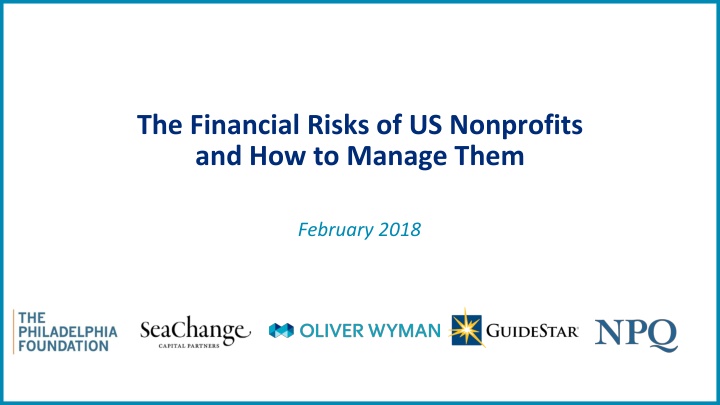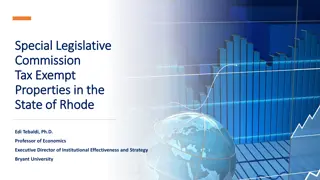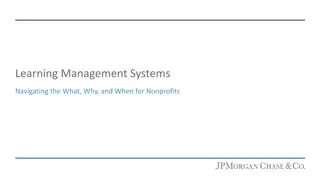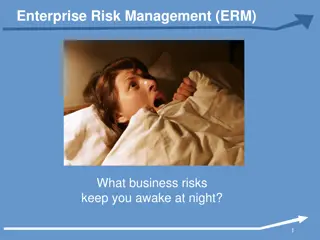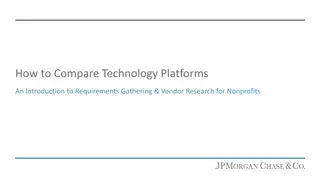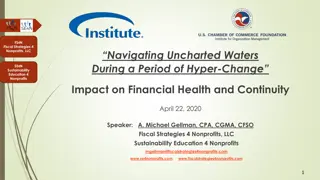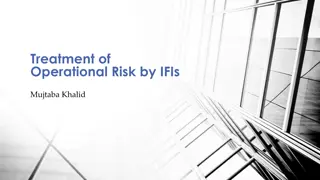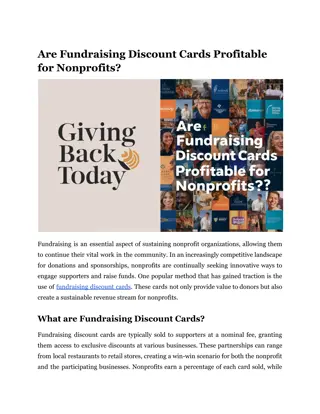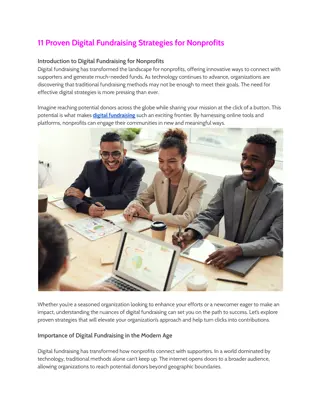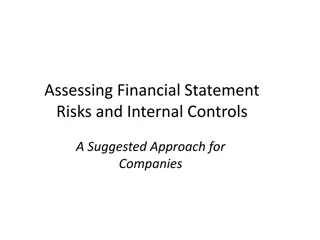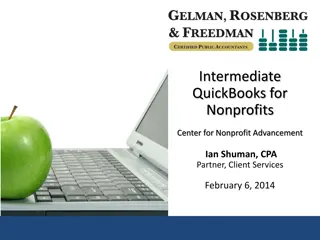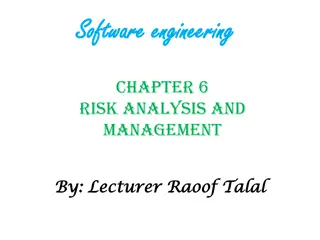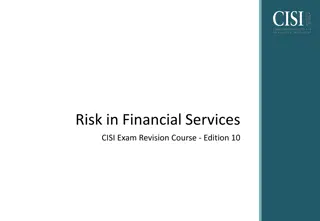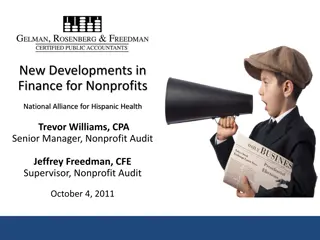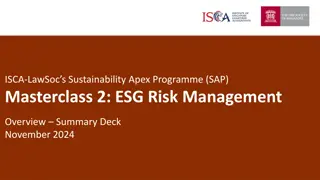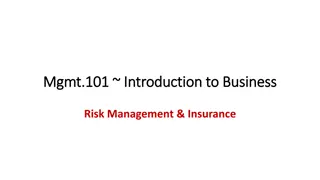Financial Risks and Management for US Nonprofits
Board members, executive directors, funders, and policymakers face increasing focus on financial risk management for nonprofits. With challenges like tax cuts, opioids, managed care, and inequality, there is a growing need for sustainable strategies. Learn about the financial health of US nonprofits, the importance of risk management, and the impact on society. Explore actionable recommendations and insights to strengthen the sector and achieve better outcomes.
Download Presentation

Please find below an Image/Link to download the presentation.
The content on the website is provided AS IS for your information and personal use only. It may not be sold, licensed, or shared on other websites without obtaining consent from the author.If you encounter any issues during the download, it is possible that the publisher has removed the file from their server.
You are allowed to download the files provided on this website for personal or commercial use, subject to the condition that they are used lawfully. All files are the property of their respective owners.
The content on the website is provided AS IS for your information and personal use only. It may not be sold, licensed, or shared on other websites without obtaining consent from the author.
E N D
Presentation Transcript
The Financial Risks of US Nonprofits and How to Manage Them February 2018
Why is risk management a hot topic right now? Board members, executive directors, funders and policy makers are increasingly focused on financial risk, but there is little to guide them A sense that the status-quo is unsustainable and the environment isn t getting any easier (tax cuts, opioids, managed care, inequality, aging, etc.) In response, we have done a series of analyses varying by depth, geography and sector: Risk Management for Nonprofits (2016) The Financial Health of Philadelphia-Area Nonprofits (2017) The Financial Heath of the United States Nonprofit Sector (2018) A National Imperative: Joining Forces to Strengthen Human Services in America (2018) Our goals: Fact-based baseline for discussion Actionable recommendations A call to action for organizations and funders 1 1
Turn-to Resource Impact/Asset Growth Civic Leadership Our Organization
The Philadelphia Context The Philadelphia Foundation has 10 years of capacity building grantmaking experience Strong belief that good governance + strong leadership + solid financials = bigger impact and better outcomes Committed to a Rising Tide and Diversity, Equity and Inclusion Philadelphia has not had hard data on the financial health of its nonprofits that are crucial to the quality of life The environment isn t getting any easier with a precarious social safety net and fragile government funding New York report report was a good base but needed to be made locally relevant through data, language and local sponsorship The report was well received and has been generating discussion at the country and city level where much of the real action is 3 3
US nonprofits central to society, providing vital services and employing ~10% of workers are in a precarious position1 While the median nonprofit is okay : 3-year margins of 2.2%, 4.4 months of expenses in cash and investments A healthy balance of public and private (~25%) funding This masks considerable weakness: 7-8% are technically insolvent (i.e. liabilities exceed assets) 30% have lost money over the last three years 30% have less than two months of cash 50% have less than one month of operating reserves Restoring the solvency gap would require $40-$50 billion 1 Based on Form 990s for 219,987 organizations with $2.45 trillion of expenses collected and maintained by GuideStar 4 4
But it is largely meaningless to talk broadly about the nonprofit sector given the diversity of the organizations within it . . . Scale and concentration: Very Small (<$1 million, 66% of orgs., 2% of spend) Large and Very Large (>$10 million, 2% of orgs., 80% of spend) For $10 million+ orgs., 70% have less than 15% philanthropy, 50% have less than 3% philanthropy) Hospitals (9% orgs., 46% spend), Education (16% orgs., 25% spend) Sub-sector diversity: Environment, Religious, Arts & Culture (philanthropy of 50%+) Health and Human Services, Youth Development, Community Capacity (philanthropy ranges between 3%-15%) 5 5
On an aggregate basis, what can we say about drivers of financial health? Size matters (a little): Similar levels of insolvency May face more liquidity issues Lower margins on average but lower range of margins Sub-sector matters a lot: Government contracts/fee for service (Hospitals, Human Services, Education) = more debt, smaller reserves High philanthropy = less debt, larger reserves Geography does not matter much 6 6
What does this all mean? No surprise and no shame: Hard problems, cost-minus (and inflexible) funding, one-way bets Zero-sum philanthropy, cost disease, recruiting & retention But those living close to the edge must focus on managing financial risk: Little margin for error Few ways to recover Risk of becoming a zombie Distress including bankruptcy creates hardship among clients and employees Funders must help as the scale of the problem means nonprofits cannot do it alone 7 7
How do nonprofits fail? Fragile to begin with Longstanding challenge in recruiting/retaining a strong CFO Crisis precipitated by an event (departure of ED, non-renewal of a funder, real estate project, contingent liability, etc.) Failed to do explicit scenario planning Board was not fully aware of important long-term trends because of focus on annual budgets and backward-looking comparisons Board did not get timely, actionable information at the appropriate level of detail early in the crisis Board took too long to realize there was a problem and then delayed taking action even when they knew it was necessary Boards and EDs suffered from magical thinking 8 8
What should nonprofits do? Review our data (or better data if you can find it) and see where you fit among your peers in terms of size, margin, reserves, etc. Develop a plan to adopt the other risk management processes: Assign explicit governance responsibility for risk management Board composition Environment scan, benchmarking, self-rating Reporting and disclosure Scenario and continuity planning Culture and a willingness to say No Recognize that partnerships, consolidations, divestments, even orderly wind-downs are part of a vibrant non-profit sector 9 9
What can funders do? Encourage grantees to take a risk management approach Support the full cost of operations Offer advice and flexible funding Consider pooled and/or nontraditional (i.e. non-grant) forms of support Normalize the discussion of outsourcing, shared services, collaborations and even orderly wind-downs Look at grantees boards of directors Use multiple approaches to assess nonprofit health 10 10
Discussion 11 11
Thank you! Nonprofit Quarterly provides these webinars free to our community; please consider going to https://nonprofitquarterly.networkforgood.com/ to support us!
